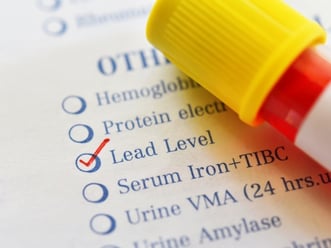No level of lead is safe. It has no biological role in the body. In fact, it is a cumulative toxicant that affects multiple body systems, including the neurological, hematological, gastrointestinal, cardiovascular and renal systems. Children are particularly vulnerable to its neurotoxic effects, and even low levels in blood have been shown to affect learning and academic achievement.

And yet, it is all around us. Sources include housing contaminated with lead-based paint; lead service lines for drinking water; soil contaminated by historical sources of lead, including automobile gasoline; and activities such as lead mining or smelting. Children may also be exposed through ingestion of contaminated candies and food packaging; some folk remedies, cultural and consumer products; and lead dust that caregivers might bring home on their clothing from their workplaces.
"Lead is one of these major environmental issues that is hiding in plain sight," said Bret Ericson, PhD., the lead author of a
recent study on childhood lead poisoning in low- and middle-income countries.
Why so dangerous?
Once ingested, lead is absorbed through the digestive tract and distributed via the bloodstream throughout the body, most significantly affecting the kidneys, liver, heart and central nervous system, as well as the haemopoietic, endocrine and reproductive systems. Like calcium, it is stored in teeth and bones, where it builds up over time to be released into the bloodstream in demanding situations, such as during pregnancy or when a bone is broken or when calcium blood levels are low.
The amount of lead in blood is referred to as blood lead level, which is measured in micrograms of lead per deciliter of blood (μg/dL). In October 2021, the U.S. Centers for Disease Control and Prevention changed its blood lead reference value (BLRV) from 5 µg/dL down to 3.5 µg/dL.
Nearly 1.5 per cent of annual global deaths (900,000) are lead fatalities. That is almost as many deaths as result from HIV/AIDS (954,000) and more than from malaria (620,000), war and terrorism (150,000) or natural disasters (90,000). However, annual deaths capture only a small slice of lead’s true impacts.
Lead is particularly destructive to children under the age of five, as it damages their brains before they have had the opportunity to fully develop, causing them lifelong neurological, cognitive and physical impairment. Childhood lead exposure has also been linked to mental health and behavioral problems, and to an increase of crime and violence. Older children suffer severe consequences including increased risk of kidney damage and cardiovascular diseases in later life.
Low- and middle-income countries
While blood lead levels in high-income countries have declined dramatically with the phase-out of leaded gasoline -- dropping from a geometric mean blood lead level of 12.8 µg/dL in the United States in 1976 to one of less than 1 µg/dL by 2016 -- blood lead levels in millions of children living in some low-and-middle-income countries remain persistently elevated, even in the absence of leaded gasoline.
One of the most concerning sources of lead exposure is the unsound recycling of used lead-acid batteries (ULABs), most often found in cars, trucks and other vehicles. Recycling activities are often conducted in informal, unlicensed, and frequently illegal open-air operations close to homes and schools. According to the World Lead Factbook by the International Lead and Zinc Study Group, about 85 per cent of all lead used goes to produce lead-acid batteries. The vast majority of this lead comes from recycled automobile batteries.
Prevention, not treatment
Once lead has been in the body for a prolonged period of time, it is very difficult to remove, as it is frequently deposited in bones. By this point, much of the neurodevelopmental damage has already been done. Primary prevention (i.e., the elimination of exposure to lead at its source) is the single most effective intervention against lead poisoning.
A diet high in iron, vitamin C and calcium can also reduce the body's absorption of lead. With enough iron and calcium in the body, less lead is absorbed. But a good diet is not a replacement for mitigating exposure to a source of lead.
Other preventive actions include:
Eliminating use
- Phase out the use of lead additives in motor and aviation fuels in countries where this has not yet been done.
- Phase out the use of lead in paints on a worldwide basis.
- Eliminate the use of leaded solder in food and drink cans, as well as in water pipes.
- Eliminate the use of lead in homes, schools, school materials and children’s toys.
- Eliminate the use of lead glazing for pottery intended for cooking, eating or drinking.
- Encourage the removal of plumbing and fittings containing lead. (Other, less costly measures -- such as corrosion control and minimizing the dissolving of lead in water systems – can be implemented until removal is completed.)
- Identify and eliminate lead use in traditional medicines and cosmetics.
Preventing exposure
- Put in place occupational standards to protect workers from exposure.
- Prevent exposure to lead from electronic waste (e.g., lead-acid batteries, computers), particularly for children.
- Ensure that the recycling of lead-containing waste is undertaken only in the presence of appropriate industrial hygiene measures and that informal recycling and use of lead- containing waste are discouraged.
- Identify contaminated sites and take necessary action to prevent human exposure to lead from these areas.
In the United States, lead in drinking water has been top of mind since October 2015, when approximately 99,000 residents of the City of Flint, Michigan, were exposed to lead when the drinking water source was switched from the Detroit Water Authority to the Flint Water System. In December 2015, lead contamination in the system was declared a state of emergency and, by January 2016, CDC – led by the Department of Health and Human Services (HHS) – assisted the City of Flint and the State of Michigan to develop a response and recovery plan.



Share Article